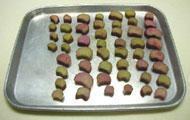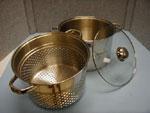Freezing FAQ's
Freezing food can be easy and economical. Preparing the food for freezing and using proper packaging can result in good quality food after freezing. Here are some questions and answers to common freezing questions.
Freezing Practices
 Why should the amount of food frozen at one time be limited to 2 to 3 pounds per cubic foot of freezer space?
Why should the amount of food frozen at one time be limited to 2 to 3 pounds per cubic foot of freezer space?
The unfrozen food should freeze within 24 hours. Overloading slows down the rate of freezing. Foods that freeze too slowly may lose quality or spoil.
When is it safe to refreeze frozen foods that have thawed?
It is safe if the food still contains ice crystals or if they are still cold (about 40oF) and have been held at this temperature no longer than 1 or 2 days after thawing.
What is the purpose of blanching vegetables?
Blanching stops the action of enzymes. if enzymes remain active during freezer storage, they can cause undesirable changes in flavor, texture, and color as well as loss of vitamin A and C.
How much boiling water should be sued for one pound of vegetables?
At least one gallon.
When should you start to count the blanching time?
As soon as the vegetable is lowered into the boiling water.
Why are the blanching times for corn-on-the-cob longer than cut corn?
To destroy the enzymes in the cob. These enzymes can cause undesirable flavor changes in the corn kernels during freezer storage.
What would you tell someone who asks if it is safe to eat green beans that were frozen without blanching?
They are safe to eat. However, the quality of the beans may be poor.
 Why are some fruits treated with ascorbic acid before freezing?
Why are some fruits treated with ascorbic acid before freezing?
To prevent the fruit from darkening.
Can you freeze raw tomatoes?
Yes. However, the quality when thawed is poor. Prepare as for canning raw or hot pack so that at least skins and cores are removed. Quarter and pack into rigid freezer containers. Frozen tomatoes are good in soups and stews.
Freezing Equipment
What kind of packaging materials are used to prevent foods from drying gout in the freezer?
Two types of moisture-vapor-proof materials are rigid plastic containers and glass jars. Two types of moisture-vapor-resistant materials are heavy aluminum foil and laminated freezer paper. Other types of freezing materials are plastic freezer bags and saran-type wraps.
 Can Aluminum foil be used as packaging?
Can Aluminum foil be used as packaging?
Use heavy duty aluminum foil as freezer wrap. It is best to use it as an overwrap since it can be torn or punctured easily. Do not use light weight aluminum foil.
Is wax paper a good freezer wrap?
No. Wax paper is not moisture-vapor resistant.
Can plastic bread wrapping be used to freeze foods?
No. Bread wrapping is not a good moisture-vapor resistant wrap. Use a freezer-weight polyethylene bag for freezing. These are bags especially designed for freezing.
Can cardboard milk or cottage cheese cartons be used for freezing?
Not for long-term storage. They are not a good moisture-vapor resistant package.
Can glass jars be used to freeze food?
Use wide-mouth dual purpose jars made for freezing and canning. The glass in these jars has been tempered to withstand the extreme temperatures. Standard canning jars can be used but be sure to leave extra headspace for expansion. THe recommendation is 3/4 inch for pints and 1 1/2 inch for quarts. Jars not intended for canning or freezing should not be used because they can break easily at extreme temperatures.
What is the best way to check the freezer temperature?
Buy a freezer thermometer. Place in the freezer and check frequently.
Is it more economical to buy a freezer?
To make the best use of a freezer, keep it full, don't just store the food, and rotate the food to use up older food first.
Which type of freezer is best, a chest or upright?
This is usually based on personal preference and space. An upright takes less space and is easier to organize. A chest freezer can be more economical.